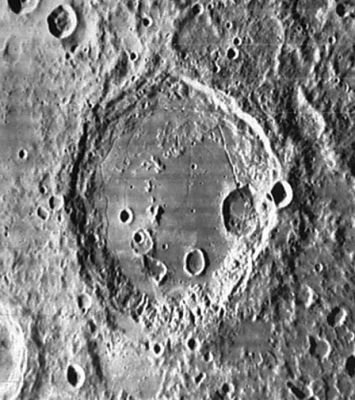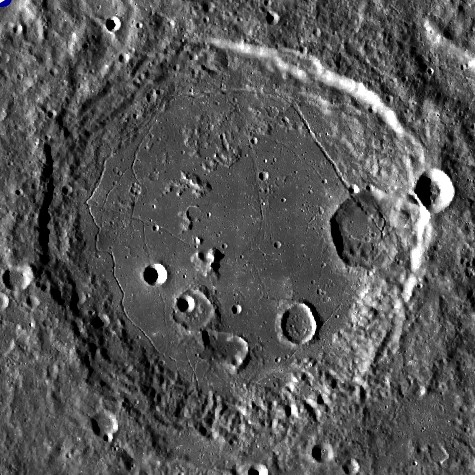Difference between revisions of "Gauss"
(Created page with "<div id="content_view" class="wiki" style="display: block"> =Gauss - and "Rimae Gauss" on its floor= {| class="wiki_table" | Lat: 35.7°N, Long: 79.0°E, Diam: 177 km, Dep...") |
|||
| (3 intermediate revisions by the same user not shown) | |||
| Line 3: | Line 3: | ||
{| class="wiki_table" | {| class="wiki_table" | ||
| | | | ||
| − | Lat: 35.7°N, Long: 79.0°E, Diam: 177 km, Depth: 2.64 km, [http://the-moon. | + | Lat: 35.7°N, Long: 79.0°E, Diam: 177 km, Depth: 2.64 km, [http://the-moon.us/wiki/R%C3%BCkl%2016 Rükl: 16], [http://the-moon.us/wiki/Stratigraphy Nectarian]<br /> |
|} | |} | ||
<div id="toc"> | <div id="toc"> | ||
| − | + | [http://www.lpod.org/coppermine/displayimage.php?pid=255&fullsize=1 [[Image:Normal_Gauss-LOIV-165H2.jpg|external image normal_Gauss-LOIV-165H2.jpg]]][[Image:Gauss.jpg|Gauss.jpg]]<br /> Upper image''':''' [http://lpod.org/coppermine/displayimage.php?pos=-255 LOIV-165-h2] (Lunar Orbiter 4).<br /> Lower image''':''' Lunar Reconnaissance Orbiter (LRO).<br /> Note the system of rilles on the floor of '''Gauss''' ("'''Rimae Gauss'''").<br /> <br /> | |
| − | |||
==Images== | ==Images== | ||
[http://www.lpod.org/coppermine/thumbnails.php?album=search&type=full&search=Gauss LPOD Photo Gallery] [http://www.lpi.usra.edu/resources/lunar_orbiter/bin/srch_nam.shtml?Gauss%7C0 Lunar Orbiter Images] [http://www.lpi.usra.edu/resources/apollo/search/feature/?feature=Gauss Apollo Images]<br /> <br /> | [http://www.lpod.org/coppermine/thumbnails.php?album=search&type=full&search=Gauss LPOD Photo Gallery] [http://www.lpi.usra.edu/resources/lunar_orbiter/bin/srch_nam.shtml?Gauss%7C0 Lunar Orbiter Images] [http://www.lpi.usra.edu/resources/apollo/search/feature/?feature=Gauss Apollo Images]<br /> <br /> | ||
==Maps== | ==Maps== | ||
| − | ''([http://the-moon. | + | ''([http://the-moon.us/wiki/LAC%20zone LAC zone] 28C3)'' [http://planetarynames.wr.usgs.gov/images/Lunar/lac_28.pdf USGS Digital Atlas PDF]<br /> <br /> |
==Description== | ==Description== | ||
<br /> | <br /> | ||
==Description: Elger== | ==Description: Elger== | ||
| − | ''([http://the-moon. | + | ''([http://the-moon.us/wiki/IAU%20directions IAU Directions])'' GAUSS.--A large, and nearly circular walled-plain, 111 miles in diameter, situated close to the N.E. limb, and consequently always foreshortened into a more or less elongated ellipse. But for this it would be one of the grandest objects in the first quadrant. Under the designation of "Mercurius Falsus" it received great attention from [http://the-moon.us/wiki/Johann%20Schr%C3%B6ter Schroter], who gives several representations of it in his <u>Selenotopographische Fragmente</u>, which, though drawn in his usual conventional style, convey a juster idea of its salient features than many subsequent drawings made under far better optical conditions. The border, especially on the E., is very complex, and is discontinuous on the S., where it is intersected by more than one pass, and is prolonged far beyond the apparent limits of the formation. The most noteworthy feature is the magnificent mountain chain which traverses the floor from N. to S. It is interesting to watch the progress of sunset thereon, and see peak after peak disappear, till only the great central boss and a few minute glittering points of light, representing the loftier portions of the chain, remain to indicate its position. [http://the-moon.us/wiki/Beer%20and%20M%C3%A4dler Madler] expatiates on the sublime view which would be obtained by any one standing on the highest peak and observing the setting sun on one side of him and the nearly "full" earth on the other; while beneath him would lie a vast plain, shrouded in darkness, surrounded by the brilliantly illuminated peaks on the lofty border, gradually passing out of sunlight. In addition to the central mountain range, there are some large rings, craters, hillocks, &c., on the floor; and on the inner slope of the E. border there is a very large circular enclosure resembling a ring-plain, not recorded in the maps. [http://the-moon.us/wiki/Julius%20Schmidt Schmidt] shows a row of large craters on the outer slope of the W. border. Of these, one is very conspicuous under a low evening sun, by reason of its brilliant walls and interior. In the region between [http://the-moon.us/wiki/Gauss Gauss] and [http://the-moon.us/wiki/Berosus Berosus] is a number of narrow steep ridges which follow the curvature of the W. wall.<br /> <br /> |
==Description: Wikipedia== | ==Description: Wikipedia== | ||
[http://en.wikipedia.org/wiki/Gauss_(crater) Gauss]<br /> <br /> | [http://en.wikipedia.org/wiki/Gauss_(crater) Gauss]<br /> <br /> | ||
==Additional Information== | ==Additional Information== | ||
| − | * Depth data from [http://the-moon. | + | * Depth data from [http://the-moon.us/wiki/Kurt%20Fisher%20Crater%20Depths Kurt Fisher database] |
** Westfall, 2000: 2.64 km | ** Westfall, 2000: 2.64 km | ||
** Cherrington, 1969: 3.96 km | ** Cherrington, 1969: 3.96 km | ||
* Central peak height | * Central peak height | ||
| − | ** [http://the-moon. | + | ** [http://the-moon.us/wiki/Sekiguchi%2C%201972 Sekiguchi, 1972]: mountain blocks on NE part of floor 0.7 on their eastern side. <span class="membersnap">- fatastronomer</span> |
* Floor-fractured crater with rilles and dark halo crater | * Floor-fractured crater with rilles and dark halo crater | ||
<br /> | <br /> | ||
| Line 29: | Line 28: | ||
* Named for [http://en.wikipedia.org/wiki/Carl_Friedrich_Gauss Johann Carl Friedrich Gauss](30 April 1777 – 23 February 1855), a German mathematician and scientist of profound genius who contributed significantly to many fields, including number theory, analysis, differential geometry, geodesy, magnetism, astronomy, and optics. Sometimes known as "the prince of mathematicians" and "greatest mathematician since antiquity", Gauss had a remarkable influence in many fields of mathematics and science and is ranked as one of history's most influential mathematicians. | * Named for [http://en.wikipedia.org/wiki/Carl_Friedrich_Gauss Johann Carl Friedrich Gauss](30 April 1777 – 23 February 1855), a German mathematician and scientist of profound genius who contributed significantly to many fields, including number theory, analysis, differential geometry, geodesy, magnetism, astronomy, and optics. Sometimes known as "the prince of mathematicians" and "greatest mathematician since antiquity", Gauss had a remarkable influence in many fields of mathematics and science and is ranked as one of history's most influential mathematicians. | ||
| − | * According to ''[http://the-moon. | + | * According to ''[http://the-moon.us/wiki/Whitaker Whitaker]'' (p. 94), the name '''Mercurius falsus''' (a reference to Riccioli's [http://the-moon.us/wiki/Mercurius Mercurius]) mentioned by Elger (above) was assigned by [http://the-moon.us/wiki/Lichtenberg Lichtenberg] to this feature whose position had been measured by [http://the-moon.us/wiki/Tobias%20Mayer Tobias Mayer]. |
| − | * [http://the-moon. | + | * [http://the-moon.us/wiki/Beer%20and%20M%C3%A4dler Beer and Mädler] changed the name to '''Gauss''' (for example, [http://books.google.com/books?id=pzIAAAAAQAAJ&pg=PA202#v=onepage&q&f=false Section 177], p. 202). |
| − | * Later observers followed their suggestion, and this feature became Catalog number 148 in Mary Blagg's ''[http://the-moon. | + | * Later observers followed their suggestion, and this feature became Catalog number 148 in Mary Blagg's ''[http://the-moon.us/wiki/Collated%20List Collated List]'' and in the original IAU nomenclature of ''[http://the-moon.us/wiki/Named%20Lunar%20Formations Named Lunar Formations]''. |
| − | * Near '''Gauss''' was [http://the-moon. | + | * Near '''Gauss''' was [http://the-moon.us/wiki/Wilkins%20and%20Moore Wilkins and Moore]'s so-called '''Mare Incognito''', a name which was not accepted by the I.A.U. |
* To the east of '''Gauss''' was '''Liddiard''', another name proposed by Wilkins and Moore, but not accepted by the I.A.U. Liddiard was an English electrical engineer. | * To the east of '''Gauss''' was '''Liddiard''', another name proposed by Wilkins and Moore, but not accepted by the I.A.U. Liddiard was an English electrical engineer. | ||
* '''Rimae Gauss''' (an unofficial name from D. Caes for the system of rilles on the floor of '''Gauss'''). | * '''Rimae Gauss''' (an unofficial name from D. Caes for the system of rilles on the floor of '''Gauss'''). | ||
<br /> | <br /> | ||
==LPOD Articles== | ==LPOD Articles== | ||
| − | [http:// | + | [http://www2.lpod.org/wiki/December_26,_2006 A Crater with Everything.] [http://www2.lpod.org/wiki/February_16,_2006 Gaussian Blur]<br /> <br /> |
==Bibliography== | ==Bibliography== | ||
| − | Hill, Harold. ''[http://the-moon. | + | Hill, Harold. ''[http://the-moon.us/wiki/A%20Portfolio%20of%20Lunar%20Drawings A Portfolio of Lunar Drawings]'', pages 40, 41.<br /> <br /> <br /> |
---- | ---- | ||
| − | + | </div> | |
Latest revision as of 21:14, 16 April 2018
Contents
Gauss - and "Rimae Gauss" on its floor
|
Lat: 35.7°N, Long: 79.0°E, Diam: 177 km, Depth: 2.64 km, Rükl: 16, Nectarian |


Upper image: LOIV-165-h2 (Lunar Orbiter 4).
Lower image: Lunar Reconnaissance Orbiter (LRO).
Note the system of rilles on the floor of Gauss ("Rimae Gauss").
Images
LPOD Photo Gallery Lunar Orbiter Images Apollo Images
Maps
(LAC zone 28C3) USGS Digital Atlas PDF
Description
Description: Elger
(IAU Directions) GAUSS.--A large, and nearly circular walled-plain, 111 miles in diameter, situated close to the N.E. limb, and consequently always foreshortened into a more or less elongated ellipse. But for this it would be one of the grandest objects in the first quadrant. Under the designation of "Mercurius Falsus" it received great attention from Schroter, who gives several representations of it in his Selenotopographische Fragmente, which, though drawn in his usual conventional style, convey a juster idea of its salient features than many subsequent drawings made under far better optical conditions. The border, especially on the E., is very complex, and is discontinuous on the S., where it is intersected by more than one pass, and is prolonged far beyond the apparent limits of the formation. The most noteworthy feature is the magnificent mountain chain which traverses the floor from N. to S. It is interesting to watch the progress of sunset thereon, and see peak after peak disappear, till only the great central boss and a few minute glittering points of light, representing the loftier portions of the chain, remain to indicate its position. Madler expatiates on the sublime view which would be obtained by any one standing on the highest peak and observing the setting sun on one side of him and the nearly "full" earth on the other; while beneath him would lie a vast plain, shrouded in darkness, surrounded by the brilliantly illuminated peaks on the lofty border, gradually passing out of sunlight. In addition to the central mountain range, there are some large rings, craters, hillocks, &c., on the floor; and on the inner slope of the E. border there is a very large circular enclosure resembling a ring-plain, not recorded in the maps. Schmidt shows a row of large craters on the outer slope of the W. border. Of these, one is very conspicuous under a low evening sun, by reason of its brilliant walls and interior. In the region between Gauss and Berosus is a number of narrow steep ridges which follow the curvature of the W. wall.
Description: Wikipedia
Additional Information
- Depth data from Kurt Fisher database
- Westfall, 2000: 2.64 km
- Cherrington, 1969: 3.96 km
- Central peak height
- Sekiguchi, 1972: mountain blocks on NE part of floor 0.7 on their eastern side. - fatastronomer
- Floor-fractured crater with rilles and dark halo crater
Nomenclature
- Named for Johann Carl Friedrich Gauss(30 April 1777 – 23 February 1855), a German mathematician and scientist of profound genius who contributed significantly to many fields, including number theory, analysis, differential geometry, geodesy, magnetism, astronomy, and optics. Sometimes known as "the prince of mathematicians" and "greatest mathematician since antiquity", Gauss had a remarkable influence in many fields of mathematics and science and is ranked as one of history's most influential mathematicians.
- According to Whitaker (p. 94), the name Mercurius falsus (a reference to Riccioli's Mercurius) mentioned by Elger (above) was assigned by Lichtenberg to this feature whose position had been measured by Tobias Mayer.
- Beer and Mädler changed the name to Gauss (for example, Section 177, p. 202).
- Later observers followed their suggestion, and this feature became Catalog number 148 in Mary Blagg's Collated List and in the original IAU nomenclature of Named Lunar Formations.
- Near Gauss was Wilkins and Moore's so-called Mare Incognito, a name which was not accepted by the I.A.U.
- To the east of Gauss was Liddiard, another name proposed by Wilkins and Moore, but not accepted by the I.A.U. Liddiard was an English electrical engineer.
- Rimae Gauss (an unofficial name from D. Caes for the system of rilles on the floor of Gauss).
LPOD Articles
A Crater with Everything. Gaussian Blur
Bibliography
Hill, Harold. A Portfolio of Lunar Drawings, pages 40, 41.